RUSH: Folks, I don’t know how I’m gonna do this. They had the official portrait unveiling today of Barack Hussein O and Michelle (My Belle) O, and I said, “Oh. My.” And so did the audience, when one of these portraits was unveiled. They did it at the Smithsonian. Now, I remember when the official portrait of Bill and the witch — ah, sorry — Hillary Clinton were unveiled. They did it at the White House. They had it in one of the rooms in the White House.
George Bush welcomed the Clintons in and all of their buddies and smack-dab right there in the front row was Harvey Weinstein. I’ll never forget it. Weinstein was sitting there looking all proud and smug that he had made it in that high, that far. But the ceremony was in the White House. This ceremony today was over at the Smithsonian. And they took a break. I was watching on both Fox and CNN. CNN took a little break ’cause of course they had to have their four analysts — I’m sorry — anchor and three analysts weigh in on it. And what do you think we got? Some guy named Fallon. I don’t remember his first name. He’s a supposed CNN contributor, analyst. Well, he didn’t cry, but it was (imitating Fallon), “Oh, my God, this is so wonderful, to have braininess back, to have intelligence, to have people we can be proud of, the people that can unite us.”
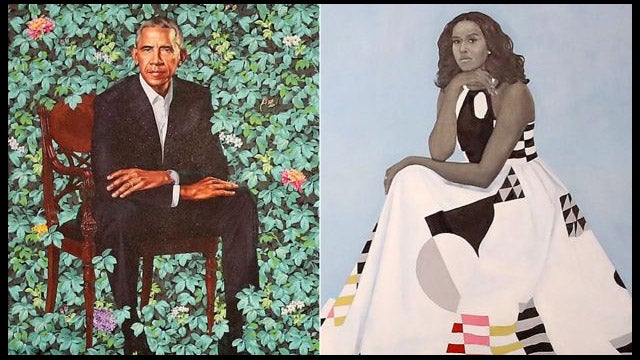 I knew it was gonna happen. So I was steeled for it. I was ready for it. But you people in the Drive-Bys are so predictable. Barack was sitting there with his head in the air like he always did, just above everything, while Michelle was going on and on and on about this artist that she found, who is a social justice artist, whatever that means. They unveiled a portrait and, you know, Brian, I wasn’t — you got it in there? All right. Flash it. All right. Here you go, folks. This is it. Untouched, undoctored. If you’re watching the Dittocam, there it is, that is the official portrait of Michelle Obama.
I knew it was gonna happen. So I was steeled for it. I was ready for it. But you people in the Drive-Bys are so predictable. Barack was sitting there with his head in the air like he always did, just above everything, while Michelle was going on and on and on about this artist that she found, who is a social justice artist, whatever that means. They unveiled a portrait and, you know, Brian, I wasn’t — you got it in there? All right. Flash it. All right. Here you go, folks. This is it. Untouched, undoctored. If you’re watching the Dittocam, there it is, that is the official portrait of Michelle Obama.
This is hard. I feel sorry. I mean, you zoom in on that, and you know what? I’m gonna let it speak for itself. I don’t need to characterize this. I really don’t. There’s not a thing I could add once you get a look at this. Well, I know the people that can’t see it are gonna have to find a way to see it, either become a subscriber at RushLimbaugh.com — that’s not a cheesy sales pitch — or find it some other way. We’ll link to it at RushLimbaugh.com, we’ll do that.
I can’t sit here and say the only way you can see this is become a member of the website. (interruption) That’s what I’m saying. I’m not gonna describe her, Mr. Snerdley. You’re trying to lure me into a trap here. You want me to set the media off. You want me blow them up so that I’ll be the lead story for next hour or two after I do it. I’m not going there. This thing speaks for itself.
I’ll just tell you, I’ve seen presidential portraits ’cause I have been in the White House. I’ve walked the hallways, and there’s a bunch of them there, and this don’t even get close to any of the — I mean, in style, I’m talking about. Forget artistic talent, just in style. I don’t know, what would you call that? To me, I’m not an artiste, and I’m not therefore a credentialed, qualified reviewer of art. Art, to me, is if I like it, fine. If I don’t, you know, I don’t see a whole lot of things that aren’t there.
Just like I’m not into poetry. Poetry is symbolism. Just tell me the way it is. You know, I don’t want to have to weed through a bunch of –. That’s why Shakespeare never really appealed. Shakespeare is philosophy in prose and I’d rather go read the translation of it, ’cause I’m just get in, get it, and get out. There’s some things I like the process of, but this to me looks — I don’t know, faded watercolors. It doesn’t look like — that’s it. I’m going no further. Other than to say I’m sorry.
Now, I haven’t lost my place. I’m gonna get to the Olympics and so forth. These guys talk about how wonderful it is to have Obama back, so wonderful, Barack and Michelle, so smart and they’re so sensitive, and they’re so nuanced. It didn’t matter what they said, didn’t matter what they did, it was the way they looked and the way they spoke and everybody healed.
BREAK TRANSCRIPT
RUSH: We’re gonna switch to the official portrait of Barack Hussein O. Go ahead and switch over there, Brian. (interruption) Look at that. I’m sorry. I don’t mean to be teasing or tempting those of you who do not have Dittocam service. But what in the world is that? Okay, I’ve gotta describe this. It’s Barack Obama sitting on what looks like a wooden throne without a high back, and he’s sitting on that throne as you might sit on yours. Except that this throne looks like it’s up against the ivy outfield wall at Wrigley Field.
It looks like he’s out there in the weeds. He’s in a forest, and the look on his… In my very unartistic estimation, it’s a better facial reproduction of Barack, but he doesn’t look happy. Is that right? (interruption) He looks kind of grim in the… (interruption) Is that right? Trying to look serious, studious and so forth. Michelle (My Belle) Obama doesn’t look happy, either, but that doesn’t mean much. These portraits people trying to look serious and very serious. But this… I’ll tell you one thing: These two portraits are gonna stand out in the White House. You’re not gonna be able to miss these on portrait row. I cannot… I just can’t.
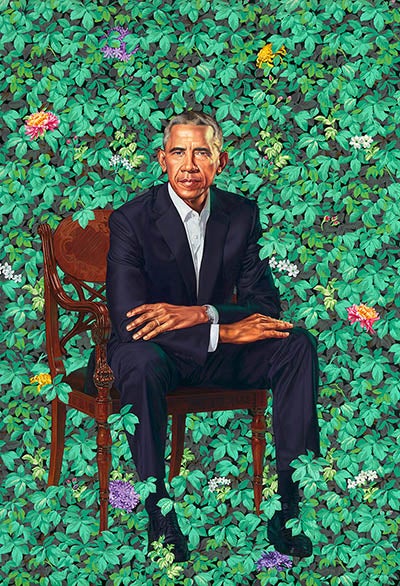 BREAK TRANSCRIPT
BREAK TRANSCRIPT
RUSH: Folks, we have some people that to want weigh in on the official Obama portraits, and normally I would keep going with the stuff I’ve got here that interest me, then go to the phones. Who knows how long it’d be from now, and I don’t want to take these two calls or three, however many it’s gonna be, an hour after I’ve talked about it. That just stops time and moves backwards. So let me get these calls, people who’ve seen these portraits and want to weigh in. We’ll start first in Springfield, New Jersey, with Janice. What are your thoughts on these?
CALLER: Well, I usually listen to you on my little Radio Shack radio as I walk through the park ’cause I can’t get you on my cell phone. But when I saw those —
RUSH: Now, the wait, wait, wait, wait, wait. Why can’t you get me on your cell phone?
CALLER: Well, would you believe I still have one of those clam phones?
RUSH: You mean a flip phone?
CALLER: Yes.
RUSH: Yeah, a lot of people do. They still use ’em on TV shows and, you know, detectives and people that try to stay hidden use those things.
CALLER: That’s my cell phone.
RUSH: I see. Well, that would explain it. Okay. So you have to take your radio with you as you’re walking in the park?
CALLER: Yeah. I just can’t afford, you know, what you call it, iPhone.
RUSH: An iPhone. Right.
CALLER: But I just want to say, with Michelle, it looked like she was wearing an old car cover I used to have with that dress of hers, and she did not look very happy.
RUSH: Now, a car cover?
CALLER: Well, look at the size of her dress.
RUSH: Oh, you’re talking about the size of it?
CALLER: Yes.
RUSH: Okay.
CALLER: I think the dress she wore to give her little speech would have been a lot better than what she was wearing. And then Obama, he didn’t look very happy, either, and besides being on a throne, he looked like he was in the middle of some pot plants, the leaves on those —
 RUSH: Yeah. You’re not the first to reference that, have that observation, that Obama appears to be out there among the doobies. (laughing) It’s weird, folks, we could describe them and we of course have and there’s no one better at that than I am, but still you have to see these. The Michelle portrait, I don’t know how to describe it. It doesn’t look like any official portrait of anything I’ve ever seen. Maybe that was the objective. Maybe that was the purpose here. I mean, when I first saw it I thought this doesn’t even look like her, really. Until you study it a little bit. Janice, thanks follow call.
RUSH: Yeah. You’re not the first to reference that, have that observation, that Obama appears to be out there among the doobies. (laughing) It’s weird, folks, we could describe them and we of course have and there’s no one better at that than I am, but still you have to see these. The Michelle portrait, I don’t know how to describe it. It doesn’t look like any official portrait of anything I’ve ever seen. Maybe that was the objective. Maybe that was the purpose here. I mean, when I first saw it I thought this doesn’t even look like her, really. Until you study it a little bit. Janice, thanks follow call.
Dan in Carmel, Indiana. Great to have you with us. How are you, sir?
CALLER: I am doing great today. How are you, Rush?
RUSH: Good, good, good. Happy to have you with us.
CALLER: Well, thank you. I’m a retired art teacher, and looking at those portraits, I’ve had kids in ninth grade do a better job of shading and adding highlights. The pictures are so flat, there’s just no definition. And the portraits —
RUSH: You know, that’s a great way to describe the Michelle Obama one. With Barack’s there is some depth to it, at least attempted. But you’re right. Flat is exactly the way to describe hers.
CALLER: Yeah. And there’s more colors in the shading of a face than just the one color.
RUSH: Well, are you saying Michelle is multicolored?
CALLER: I’m saying that if you shade a face, you don’t just see one color.
RUSH: Oh. So you got shadowing and got that kind of thing, you mean?
CALLER: Yeah. There’s depth of color, and you —
RUSH: You know, if you look at some of the impressionist artists, they’ll use complementary colors to get a shadow, and it adds depth and life to the portrait.
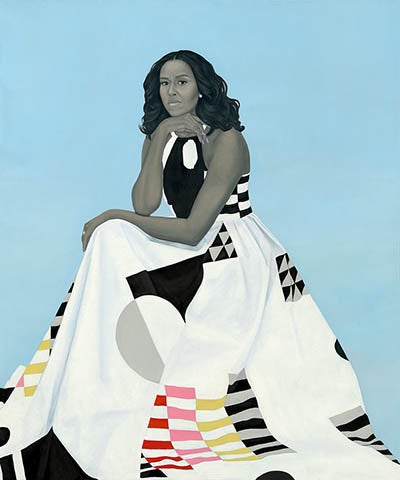 RUSH: Right. I’ve always asked art experts if they can define art for me, and if somebody asked you to define, what is art, what determines whether something’s art and something’s not art?
RUSH: Right. I’ve always asked art experts if they can define art for me, and if somebody asked you to define, what is art, what determines whether something’s art and something’s not art?
CALLER: Well, you know, I took a class in college about that, and I don’t know that we actually defined it. As you said, I think if it’s something that you like, that’s art. You know?
RUSH: I’ve heard people, you know, people that spend millions buying an old impressionist master, whatever, and they say it just makes them feel great looking at it. They just —
CALLER: Right.
RUSH: — love the way it makes ’em feel. I’ve never had that reaction looking at art.
CALLER: To any art whatsoever?
RUSH: Well, that gets back to what we call art. I guess I’m an artist. I’m a performance artist. Although I’ve never thought of myself that way. I’ve thought of myself as a radio guy. But in our current iteration of things, I would be considered a performance artist by some. But this goes back to defining what is art. There are plenty of things I look at that make me feel great, but none of them have been painted.
CALLER: Okay. Well, it might be like a fine wine. It doesn’t always depend on the price, but it depends on the taste.
RUSH: Well, a work of art, yeah, in terms of the process. But looking at the bottle and looking at a glass of it, the anticipation of it, the feeling is derived from consuming it.
CALLER: That’s true.
RUSH: And I can’t eat a painting. I’m being a little facetious here. I’m not trying to confound you or anything. And I’m not trying to put down what you do. I mean, I think art is a talent. Look at Jackson Pollock, how he accidentally discovered in a rage just throwing paint up on a wall and people pay millions for it. How do you explain that?
CALLER: Well, there was a new movement, a new way of approaching art. Actually one of my professors was an abstract expressionist like him. It was funny to watch him paint. And then he told us to, as we’re doing those paintings, we’re supposed to rotate the canvas every once in a while and then try to bring out things you might see, like you might see in a cloud, you might see —
RUSH: I got you.
CALLER: — forms or things pull out of a cloud.
RUSH: Was it determined in the art world that Jackson Pollock throwing paint on a canvas was unique and different than anybody else who would throw paint on a canvas?
CALLER: He was the first one that really came up with that whole idea, kind of like Georges Seurat with the dots, pointillism. He was the first one that did that, too. So that’s kind of a new way of looking at things. And the same thing with the impressionists, the way they were using light. At first their paintings were vilified as just sketches.
RUSH: Exactly. Those guys, back in their day, it was good, but it wasn’t anything spectacular like it is today, so it depends on standards applied to it. But before you go, I’ve always thought of art, painting and that kind of thing, I’ve always thought it was a talent that you have or you don’t. And yet you’re an art teacher. Does that mean you’re actually teaching people the various techniques of painting or you’re teaching art history?
CALLER: Well, I did both. We taught techniques and how to shade and actually a big part of it was how to see, how to see how light reflects off objects.
RUSH: Okay.
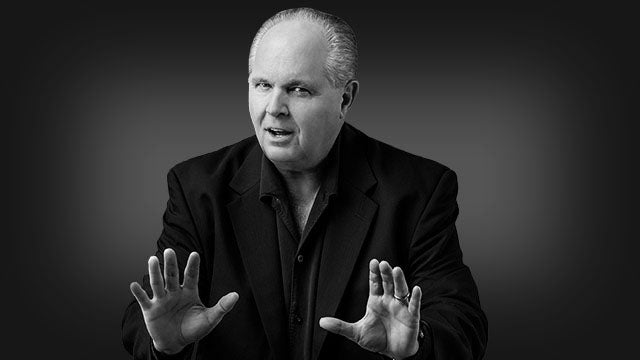 CALLER: If you paint a brick wall you should see more than just a pink brick. You should see all the different colors that are in there.
CALLER: If you paint a brick wall you should see more than just a pink brick. You should see all the different colors that are in there.
RUSH: With the Michelle painting, there’s none of that that you’re talking about here. It’s just flat. You’re exactly right. I would have never described it that way because I’m not the art expert, but when you say that, when you describe it as flat, it’s exactly what it is. And how do you explain so little color in this work?
CALLER: I don’t. Like I said, in a ninth grade drawing class you would hand it back to them and say, “You didn’t put anything in there. There’s no shadows, there’s no highlights. Where’s the light striking the face?”
RUSH: Here’s what’s gonna happen. This artist, I remember her first name is Amy. Because she was chosen and because her portrait’s gonna be hanging in the White House, we’re looking potentially here at a brand-new genre, are we not?
CALLER: Eh. I guess.
RUSH: Well, don’t be surprised. That’s the way these things work. And for Barack’s, I can’t tell you the number of people — well, I can’t tell you what they told me it looks like he’s doing. I’m gonna stop right there.
BREAK TRANSCRIPT
RUSH: I just got an email from a friend, subject line: “Some Believe the Moon Landing was Staged; I’m Wondering if Michelle Obama Is Real — If this is a portrait of the real Michelle Obama, who was that other woman we saw with the president?” Ha! (laughing) Note from a friend. Look. We got other things coming up here, folks. In fact, we’re really loaded but some more people want to weigh in on the artwork here for just a minute. We’re going to limit this to this hour. We’ll continue here with Joan in Sonoma, California. Great to have you. How are you doing?
CALLER: (garbled cell) Well, thank you, Rush. I’m pleased to speak with you. When I saw the name Kehinde Wiley was going to be the artist chosen for the presidential portrait, I was stunned. I had seen his work in a museum in Kansas City. What he does is he takes historical works, famous paintings (garbled) black people aren’t represented so he puts a black person in where the white person is in the historical painting.
RUSH: Wait a minute. But that’s not what this is.
CALLER: Well, I don’t know. I just know the one — the style from the Kansas City Museum —
RUSH: What is his name, Kehinde what?
CALLER: Kehinde Wiley.
RUSH: Kehinde Wiley.
CALLER: W-i-l-e-y.
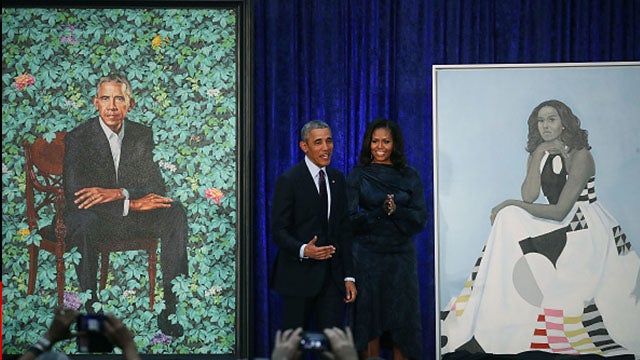 RUSH: Well, what he has said about this work, and I shall… Brian, switch to it for people watching here on the Dittocam. Put it back here to the switcher.
RUSH: Well, what he has said about this work, and I shall… Brian, switch to it for people watching here on the Dittocam. Put it back here to the switcher.
CALLER: Uh-huh.
RUSH: It is Obama sitting on a wooden throne. Uh, chair.
CALLER: Uh huh.
RUSH: But it’s four legs. It’s shaped like a throne but it’s not a high back.
CALLER: Right.
RUSH: He’s sitting leaning forward, legs are spread like… This is manspreading here. He’s leaning forward, no tie, jacket on, gigantic hands.
CALLER: Mmm-hmm.
RUSH: I mean, gigantic hands, and the background is ivy —
CALLER: Mmm-hmm.
RUSH: — and flowers.
CALLER: Right.
RUSH: What the artist has said here is that the back has captured Obama’s heritage. You’ve got Hawaii and Kenya and Chicago —
CALLER: Right.
RUSH: — that made up in the background.
CALLER: Right. So I’m reading from the Kansas City Museum. “His works reimagine famous paintings, substituting a contemporary African-American man or woman for the traditional white figure. Such images challenge the viewer to think about the dynamics of status, race, and representation.”
RUSH: Well —
CALLER: Interesting.
RUSH: Okay, so you mean he would take a Teddy Roosevelt portrait and put an African-American in the same scene —
CALLER: Correct.
RUSH: — as an example?
CALLER: Right. And the one in Kansas City is, uh, (unintelligible) Saint Adrian, and he puts the black person in, only he’s in a Yankees baseball uniform (sic), and he’s… I can’t remember. He’s holding a sword and anvil to show power and heroism, and they’re all flowers.
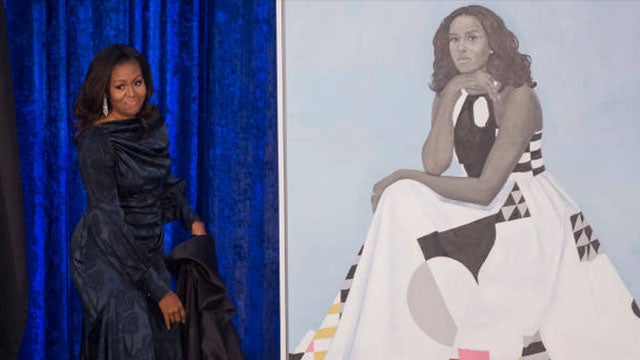 RUSH: Holding an anvil to show power and heroism wearing a Yankee baseball uniform?
RUSH: Holding an anvil to show power and heroism wearing a Yankee baseball uniform?
CALLER: Yes. No. 88.
RUSH: As Saint Adrian. That’s deep.
CALLER: Uh-huh.
RUSH: That’s really deep.
CALLER: So it’s a black woman artist who did Michelle.
RUSH: Yes. Her name is Amy Sherald, and she’s from Baltimore.
CALLER: Okay.
RUSH: And she’s known as a “social justice artist,” whatever that means.
CALLER: (laughing)
RUSH: Well, the story I have here… It’s from The Daily Caller. It says Amy Sherald “who is known for her social justice painting style.”
CALLER: Okay.
RUSH: You sound like you are in the art community. What is the “social justice painting style”?
CALLER: I don’t really know. I had a video store for 30 years, so I could tell you the amount of social justice conversation coming through my business —
RUSH: (laughing)
CALLER: — in a very small liberal town.
CALLER: All right.
RUSH: Is that it?
CALLER: Yes, that’s it. I just thought that you might be interested, and as I said, when I —
RUSH: Oh. I don’t know how I would have finished this day —
CALLER: Ah!
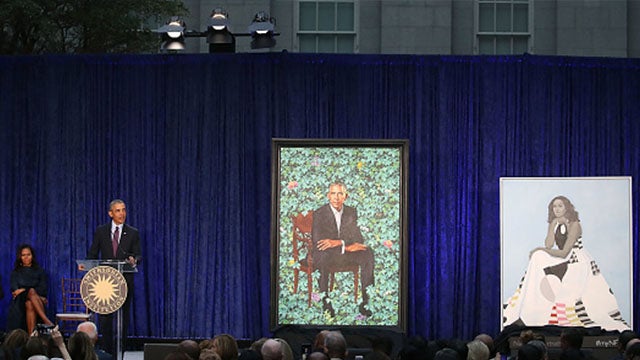 RUSH: — without knowing all of that. Yeah, you’ve done a great service here. I appreciate it. Who’s next? We have… Da-da-da. We got time for a couple more, maybe. That’d be Obi in Sanger, California. Obi, how are you?
RUSH: — without knowing all of that. Yeah, you’ve done a great service here. I appreciate it. Who’s next? We have… Da-da-da. We got time for a couple more, maybe. That’d be Obi in Sanger, California. Obi, how are you?
CALLER: Well, hey, Rush. Thanks a lot for taking my call.
RUSH: Yes, sir. Any time.
CALLER: I’ve got a comment on the paintings and I’ve got a comment on the wall.
RUSH: All right.
CALLER: First, I want to say the last time I talked with you was during the elections. I’m the fella out in loony California here that had the Trump sticker in the back of my Porsche. I’m glad we won. (chuckles)
RUSH: You’re the guy in California that had the Trump sticker on the back of his Porsche.
CALLER: Yeah. Yeah. Anyway, my comment on the painting, understand I don’t —
RUSH: Hang on just a second. Folks, we got the guy who had the Porsche in California with the Trump bumper sticker!
CALLER: Yeah.
RUSH: We’ve got the guy!
CALLER: (laughing)
RUSH: What a get for us!
CALLER: Okay.
RUSH: All right.
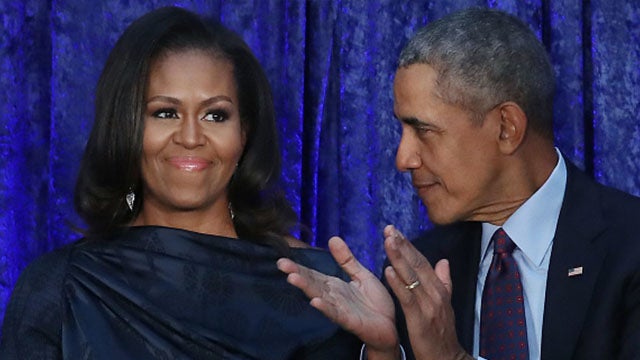 CALLER: My comment on the paintings: I looked at ’em on the internet here. I don’t like the Obamas. I’m definitely a big Trump guy. But I’ll tell you I thought the paintings looked good, I thought both of them were creative and they looked good. I don’t want to go to that deeper. Let me just move to my second comment on the wall.
CALLER: My comment on the paintings: I looked at ’em on the internet here. I don’t like the Obamas. I’m definitely a big Trump guy. But I’ll tell you I thought the paintings looked good, I thought both of them were creative and they looked good. I don’t want to go to that deeper. Let me just move to my second comment on the wall.
RUSH: You just said what you just said so that your comments on the wall will be taken seriously.
CALLER: Well, I hope they are.
RUSH: Yeah. See? I knew it. I knew it. You don’t really think it. You’re just saying that so people will think that you’re reasonable, tolerant, understanding, compassionate, and all those things. So now when you load up and fire on the wall, people are gonna listen.
CALLER: Well, it’s just a creative idea — I don’t know if it’d work — and that is this. You know, Trump is having such a hard time getting this approved, getting any cooperation from the Democrats or Congress. I’m thinking that in his capacity as commander-in-chief, why can’t he order the Army Corps of Engineers to build the wall and pay for it out of the Pentagon budget and justify it as necessary for the national defense?
RUSH: I don’t think that he wants to do it that way because I think he wants there to be a consensus behind the building of the wall. I think he wants to do this in the, quote-unquote, “right way.” And I think he’s confident he’s gonna get it done. And I think he’s confident he’s gonna get it done within the immigration fight that is taking place. To go that route… And I technically don’t know if the way you’ve laid it out here could actually be done. Commander-in-chief, granting him powers to order the wall built by who? The Army Corps of Engineers, perhaps, but I don’t know what the legalities are. I just don’t think that that’s the way he’s gonna choose to go about it.
BREAK TRANSCRIPT
RUSH: Hey. The New York Times has weighed in on the two portraits, and the New York Times says that Barack Obama’s portrait shows him “not as a self-assured, standard-issue bureaucrat, but as an alert and troubled thinker.” An alert and troubled thinker. Not self-assured, standard-issue bureaucrat. Michelle (My Belle) Obama’s portrait, according to the New York Times, “overemphasizes an element of couturial spectacle.” That’s their way of saying the dress (laughing) is too damn big. Her dress. Couturial spectacle. “[B]ut [her portrait] also projects a rock-solid cool.” So there you have it, the official weighing in for the New York Times on both portraits.
 BREAK TRANSCRIPT
BREAK TRANSCRIPT
RUSH: Charleston, South Carolina, and Reece. I’m glad you waited, sir. How are you doing?
CALLER: How are you doing, sir? Thanks for taking my call.
RUSH: You bet! Happy to.
CALLER: I was gonna say, I love the artist’s rendering of President Obama, and I think he’s actually a closet conservative, because he accurately captured what Obama did to our Constitution, our military, and Americans throughout the world in his portrait.
RUSH: Wait a minute. The artist “captured what Obama did to our Constitution, our military, and Americans throughout the world in his portrait”? How?
CALLER: Well, considering the position that he’s sitting in and what it’s implied that he’s doing, that is exactly what he did to America and our Constitution, our military —
RUSH: Okay, I just had to hear it. I wasn’t quite sure. I didn’t know if you were talking about the ivy, the weeds in the background, or the short-backed throne on which he sits. It is curious, folks. It is real curious. The portrait of Moochelle (My Belle), that’s… See, I thought we’d put the subject behind us. I’m dangerously close. I’m taking another break here.


